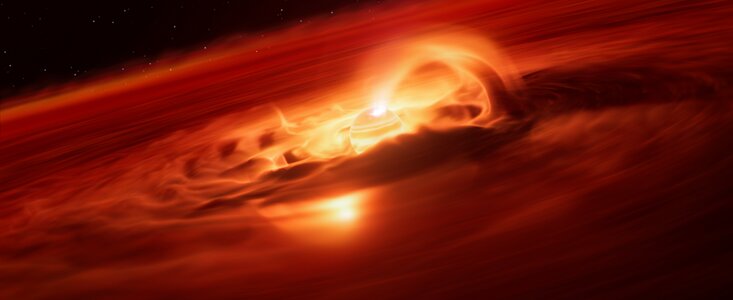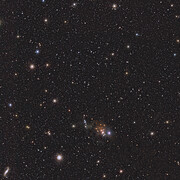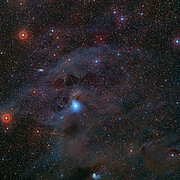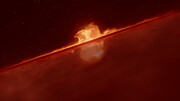Comunicato Stampa
Sei miliardi di tonnellate al secondo: scoperto un pianeta vagabondo che cresce a un ritmo record
02 Ottobre 2025
Gli astronomi hanno identificato un enorme "scatto di crescita" in un cosiddetto pianeta erratico. A differenza dei pianeti del Sistema Solare, questi oggetti non orbitano intorno a una stella, ma fluttuano liberamente, isolati. Le nuove osservazioni, effettuate con il Very Large Telescope dell'Osservatorio Europeo Australe (VLT dell'ESO), rivelano che il pianeta vagabondo sta divorando gas e polvere dai dintorni a un ritmo di sei miliardi di tonnellate al secondo. Si tratta del tasso di crescita più elevato mai registrato per un pianeta erratico, ma anche per un pianeta di qualsiasi tipo, e fornisce preziose informazioni su come i pianeti si formano e crescono.
"Molti pensano ai pianeti come a mondi tranquilli e stabili, ma con questa scoperta vediamo che oggetti di massa planetaria che fluttuano liberamente nello spazio possono essere luoghi avvincenti", afferma Víctor Almendros-Abad, astronomo dell'Osservatorio Astronomico di Palermo, Istituto Nazionale di Astrofisica (INAF), Italia, e autore principale del nuovo studio.
L'oggetto appena studiato, con una massa da cinque a dieci volte quella di Giove, si trova a circa 620 anni luce di distanza da noi nella costellazione del Camaleonte. Chiamato ufficialmente Cha 1107-7626, questo pianeta vagabondo è ancora in formazione ed è alimentato da un disco di gas e polvere che lo circonda. Questo materiale ricade costantemente sul pianeta isolato, un processo noto come accrescimento. Tuttavia, il gruppo guidato da Almendros-Abad ha ora scoperto che il tasso di accrescimento del giovane pianeta non è costante.
Nell'agosto del 2025, l'accrescimento sul pianeta aveva un tasso circa otto volte superiore rispetto a quello di pochi mesi prima, pari a sei miliardi di tonnellate al secondo! "Questo è l'episodio di accrescimento più intenso mai registrato per un oggetto di massa planetaria", aggiunge Almendros-Abad. La scoperta, che sarà pubblicata su The Astrophysical Journal Letters, è stata realizzat con lo spettrografo X-shooter installato sul VLT dell'ESO, situato nel deserto di Atacama in Cile. Il gruppo ha utilizzato anche i dati del telescopio spaziale James Webb, gestito dalle agenzie spaziali di USA, Europa e Canada, e i dati d'archivio dello spettrografo SINFONI installato sul VLT dell'ESO.
"L'origine dei pianeti erratici rimane una questione non risolta: sono gli oggetti di formazione stellare con la minima massa possibile o pianeti giganti espulsi dai propri sistemi di origine?", si chiede il coautore Aleks Scholz, astronomo presso l'Università di St Andrews, Regno Unito. I risultati indicano che almeno alcuni pianeti vagabondi potrebbero condividere un percorso di formazione simile a quello delle stelle, poiché simili aumenti rapidi del tasso di accrescimento sono stati osservati in precedenza in stelle giovani. Come spiega la coautrice Belinda Damian, astronoma presso l'Università di St Andrews: "Questa scoperta sfuma il confine tra stelle e pianeti e ci offre un'anteprima dei primi periodi di formazione dei pianeti vagabondi".
Confrontando la luce emessa prima e durante l'aumento, gli astronomi hanno raccolto indizi sulla natura del processo di accrescimento. Sorprendentemente, l'attività magnetica sembra aver giocato un ruolo nel guidare la drastica caduta di massa, un fenomeno osservato finora solo nelle stelle. Ciò suggerisce che anche oggetti di piccola massa possano possedere forti campi magnetici in grado di alimentare questi eventi di accrescimento. Il gruppo ha anche scoperto che la chimica del disco intorno al pianeta è cambiata durante l'episodio di accrescimento, con la presenza di vapore acqueo durante l'evento ma non prima. Questo fenomeno era stato osservato nelle stelle, ma mai in un pianeta di alcun tipo.
I pianeti liberi sono difficili da rivelare, poiché sono molto deboli, ma il futuro ELT (Extremely Large Telescope) dell'ESO potrebbe cambiare la situazione. I suoi potenti strumenti e il gigantesco specchio principale consentiranno agli astronomi di scoprire e studiare un numero maggiore di questi pianeti solitari, aiutando a comprendere meglio quanto siano simili a stelle. Come afferma la coautrice e astronoma dell'ESO Amelia Bayo: "L'idea che un oggetto planetario possa comportarsi come una stella è suggestivo e ci invita a chiederci come potrebbero essere i mondi oltre il nostro durante le fasi iniziali".
Ulteriori Informazioni
Questo risultato è stato presentato nell'articolo intitolato “Discovery of an Accretion Burst in a Free-Floating Planetary-Mass Object” to appear in The Astrophysical Journal Letters (doi:10.3847/2041-8213/ae09a8).
L'equipe è composta da V. Almendros-Abad (Istituto Nazionale di Astrofisica - Osservatorio Astronomico di Palermo, Italy), Aleks Scholz (School of Physics & Astronomy, University of St Andrews, Regno Unito [St Andrews]), Belinda Damian (St Andrews), Ray Jayawardhana (Department of Physics & Astronomy, Johns Hopkins University, USA [JHU]), Amelia Bayo (European Southern Observatory, Germania), Laura Flagg (JHU), Koraljka Mužić (Instituto de Astrofísica e Ciências do Espaço, Faculdade de Ciências, Universidade de Lisboa, Portogallo), Antonella Natta (School of Cosmic Physics, Dublin Institute for Advanced Studies and University College Dublin, Irlanda) Paola Pinilla (Mullard Space Science Laboratory, University College London, Regno Unito) e Leonardo Testi (Dipartimento di Fisica e Astronomia, Università di Bologna, Italy).
L'ESO (European Southern Observatory o Osservatorio Europeo Australe) consente agli scienziati di tutto il mondo di scoprire i segreti dell'Universo a beneficio di tutti. Progettiamo, costruiamo e gestiamo da terra osservatori di livello mondiale - che gli astronomi utilizzano per affrontare temi interessanti e diffondere il fascino dell'astronomia - e promuoviamo la collaborazione internazionale per l'astronomia. Fondato come organizzazione intergovernativa nel 1962, oggi l'ESO è sostenuto da 16 Stati membri (Austria, Belgio, Danimarca, Francia, Finlandia, Germania, Irlanda, Italia, Paesi Bassi, Polonia, Portogallo, Regno Unito, Repubblica Ceca, Spagna, Svezia e Svizzera), insime con il paese che ospita l'ESO, il Cile, e l'Australia come partner strategico. Il quartier generale dell'ESO e il Planetario e Centro Visite Supernova dell'ESO si trovano vicino a Monaco, in Germania, mentre il deserto cileno di Atacama, un luogo meraviglioso con condizioni uniche per osservare il cielo, ospita i nostri telescopi. L'ESO gestisce tre siti osservativi: La Silla, Paranal e Chajnantor. Sul Paranal, l’ESO gestisce il VLT (Very Large Telescope) e il VLTI (Very Large Telescope Interferometer), così come due telescopi per survey, VISTA, che lavora nell'infrarosso, e VST (VLT Survey Telescope) in luce visibile. Sempre a Paranal l'ESO ospiterà e gestirà la schiera meridionale di telescopi di CTA, il Cherenkov Telescope Array Sud, il più grande e sensibile osservatorio di raggi gamma del mondo. Insieme con partner internazionali, l’ESO gestisce APEX e ALMA a Chajnantor, due strutture che osservano il cielo nella banda millimetrica e submillimetrica. A Cerro Armazones, vicino a Paranal, stiamo costruendo "il più grande occhio del mondo rivolto al cielo" - l'ELT (Extremely Large Telescope, che significa Telescopio Estremamente Grande) dell'ESO. Dai nostri uffici di Santiago, in Cile, sosteniamo le operazioni nel paese e collaboriamo con i nostri partner e la società cileni.
La traduzione dall'inglese dei comunicati stampa dell'ESO è un servizio dalla Rete di Divulgazione Scientifica dell'ESO (ESON: ESO Science Outreach Network) composta da ricercatori e divulgatori scientifici da tutti gli Stati Membri dell'ESO e altri paesi. Il nodo italiano della rete ESON è gestito da Anna Wolter.
Links
- Articolo scientifico
- Fotografie del VLT
- Scoprite ulteriori informazioni sull'ELT (Extremely Large Telescope) dell'ESO's sul sito dedicato e nella cartella stampa
- Per i giornalisti: iscrivetevi per ricevere i nostri comunicati sotto embargo nella vostra lingua
- Per i ricercatori: avete una storia da raccontare? Promuovete il vostro articolo scientifico
- Una nuova analisi dell'ESO conferma che gravi danni sarebbero causati dal complesso industriale pianificato vicino al Paranal
Contatti
Víctor Almendros-Abad
INAF Astronomical Observatory of Palermo
Palermo, Italy
Tel.: +39 3762144093
E-mail: victor.almendrosabad@inaf.it
Aleks Scholz
University of St. Andrews
St. Andrews, United Kingdom
Tel.: +44 (0)1334 46 1668
E-mail: as110@st-andrews.ac.uk
Belinda Damian
University of St. Andrews
St. Andrews, United Kingdom
Tel.: +44 (0)1334 46 3098
E-mail: bd64@st-andrews.ac.uk
Amelia Bayo
European Southern Observatory
Garching, Germany
Tel.: +49 89 3200 6499
E-mail: AmeliaMaria.BayoAran@eso.org
Bárbara Ferreira
ESO Media Manager
Garching, Germany
Tel.: +49 89 3200 6670
Cell.: +49 151 241 664 00
E-mail: press@eso.org
Joerg Gasser (press contact Svizzera)
Rete di divulgazione scientifica dell'ESO
E-mail: eson-switzerland@eso.org
Sul Comunicato Stampa
| Comunicato Stampa N": | eso2516it-ch |
| Nome: | Cha 1107-7626 |
| Tipo: | Milky Way : Planet |
| Facility: | Very Large Telescope |
| Instruments: | X-shooter |
| Science data: | 2025ApJ...992L...2A |
Our use of Cookies
We use cookies that are essential for accessing our websites and using our services. We also use cookies to analyse, measure and improve our websites’ performance, to enable content sharing via social media and to display media content hosted on third-party platforms.
ESO Cookies Policy
The European Organisation for Astronomical Research in the Southern Hemisphere (ESO) is the pre-eminent intergovernmental science and technology organisation in astronomy. It carries out an ambitious programme focused on the design, construction and operation of powerful ground-based observing facilities for astronomy.
This Cookies Policy is intended to provide clarity by outlining the cookies used on the ESO public websites, their functions, the options you have for controlling them, and the ways you can contact us for additional details.
What are cookies?
Cookies are small pieces of data stored on your device by websites you visit. They serve various purposes, such as remembering login credentials and preferences and enhance your browsing experience.
Categories of cookies we use
Essential cookies (always active): These cookies are strictly necessary for the proper functioning of our website. Without these cookies, the website cannot operate correctly, and certain services, such as logging in or accessing secure areas, may not be available; because they are essential for the website’s operation, they cannot be disabled.
Functional Cookies: These cookies enhance your browsing experience by enabling additional features and personalization, such as remembering your preferences and settings. While not strictly necessary for the website to function, they improve usability and convenience; these cookies are only placed if you provide your consent.
Analytics cookies: These cookies collect information about how visitors interact with our website, such as which pages are visited most often and how users navigate the site. This data helps us improve website performance, optimize content, and enhance the user experience; these cookies are only placed if you provide your consent. We use the following analytics cookies.
Matomo Cookies:
This website uses Matomo (formerly Piwik), an open source software which enables the statistical analysis of website visits. Matomo uses cookies (text files) which are saved on your computer and which allow us to analyze how you use our website. The website user information generated by the cookies will only be saved on the servers of our IT Department. We use this information to analyze www.eso.org visits and to prepare reports on website activities. These data will not be disclosed to third parties.
On behalf of ESO, Matomo will use this information for the purpose of evaluating your use of the website, compiling reports on website activity and providing other services relating to website activity and internet usage.
Matomo cookies settings:
Additional Third-party cookies on ESO websites: some of our pages display content from external providers, e.g. YouTube.
Such third-party services are outside of ESO control and may, at any time, change their terms of service, use of cookies, etc.
YouTube: Some videos on the ESO website are embedded from ESO’s official YouTube channel. We have enabled YouTube’s privacy-enhanced mode, meaning that no cookies are set unless the user actively clicks on the video to play it. Additionally, in this mode, YouTube does not store any personally identifiable cookie data for embedded video playbacks. For more details, please refer to YouTube’s embedding videos information page.
Cookies can also be classified based on the following elements.
Regarding the domain, there are:
- First-party cookies, set by the website you are currently visiting. They are stored by the same domain that you are browsing and are used to enhance your experience on that site;
- Third-party cookies, set by a domain other than the one you are currently visiting.
As for their duration, cookies can be:
- Browser-session cookies, which are deleted when the user closes the browser;
- Stored cookies, which stay on the user's device for a predetermined period of time.
How to manage cookies
Cookie settings: You can modify your cookie choices for the ESO webpages at any time by clicking on the link Cookie settings at the bottom of any page.
In your browser: If you wish to delete cookies or instruct your browser to delete or block cookies by default, please visit the help pages of your browser:
Please be aware that if you delete or decline cookies, certain functionalities of our website may be not be available and your browsing experience may be affected.
You can set most browsers to prevent any cookies being placed on your device, but you may then have to manually adjust some preferences every time you visit a site/page. And some services and functionalities may not work properly at all (e.g. profile logging-in, shop check out).
Updates to the ESO Cookies Policy
The ESO Cookies Policy may be subject to future updates, which will be made available on this page.
Additional information
For any queries related to cookies, please contact: pdprATesoDOTorg.
As ESO public webpages are managed by our Department of Communication, your questions will be dealt with the support of the said Department.








